To maintain your bike effectively, prioritize routine inspections and cleaning. Essential tools include a quality bike repair stand, an Allen wrench set, tire levers, and a chain tool. Regularly check the drivetrain, tires, and brake system for wear. Don't forget to clean and lubricate your bike to enhance performance. With these tips, you can keep your bike in top shape. Plus, there's plenty more to discover about advanced techniques and resources to simplify your maintenance routine.
Key Takeaways
- Invest in essential tools, including an Allen wrench set, tire levers, and a reliable chain tool, for effective DIY bike maintenance.
- Regularly check and maintain tire pressure to enhance grip and prolong tire lifespan.
- Use a dedicated chain brush and degreaser to keep the drivetrain clean and functioning smoothly.
- Inspect and align brake pads and calipers frequently to ensure optimal braking performance and safety.
- Consider a bike repair stand for improved ergonomics and easier access during maintenance tasks.
Importance of Bike Maintenance and Inspection
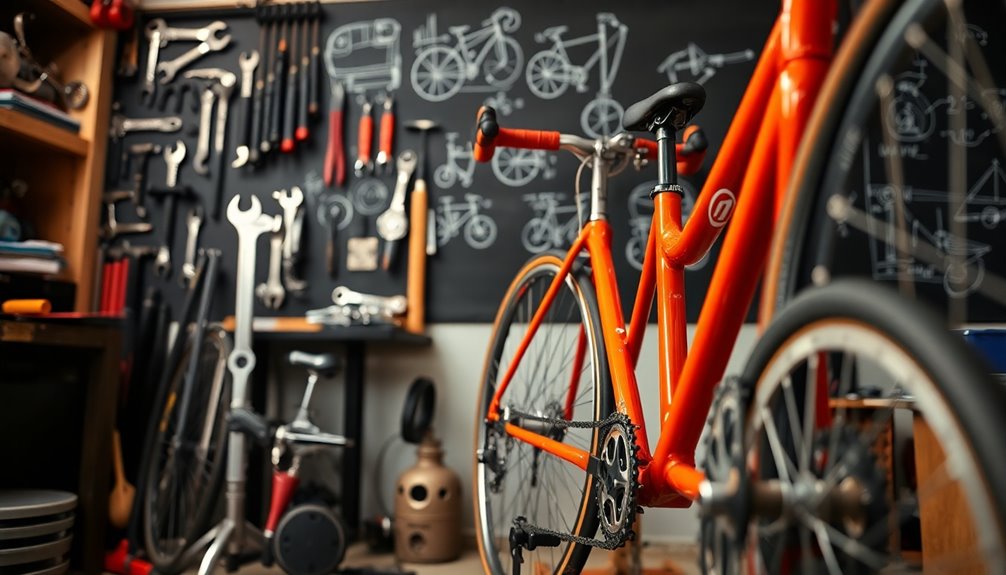
When you prioritize bike maintenance and inspection, you're not just keeping your ride in good shape; you're also enhancing its performance and reliability.
Regular maintenance tasks, like routine cleaning and visual inspections, can save you from costly bike repairs down the line. Spend just five minutes checking for loose or damaged components, and you might prevent accidents or major repairs.
By incorporating these quick checks into your routine, you'll extend the lifespan of vital bike parts like the drivetrain, which faces significant wear over time.
Plus, honing basic bike repair skills allows you to diagnose issues quickly, saving time and money.
With the right mindset and essential tools, you can keep your bike running smoothly and efficiently. Additionally, understanding the importance of regular maintenance tasks can help you identify potential issues before they escalate into costly repairs.
Essential Bike Maintenance Tools
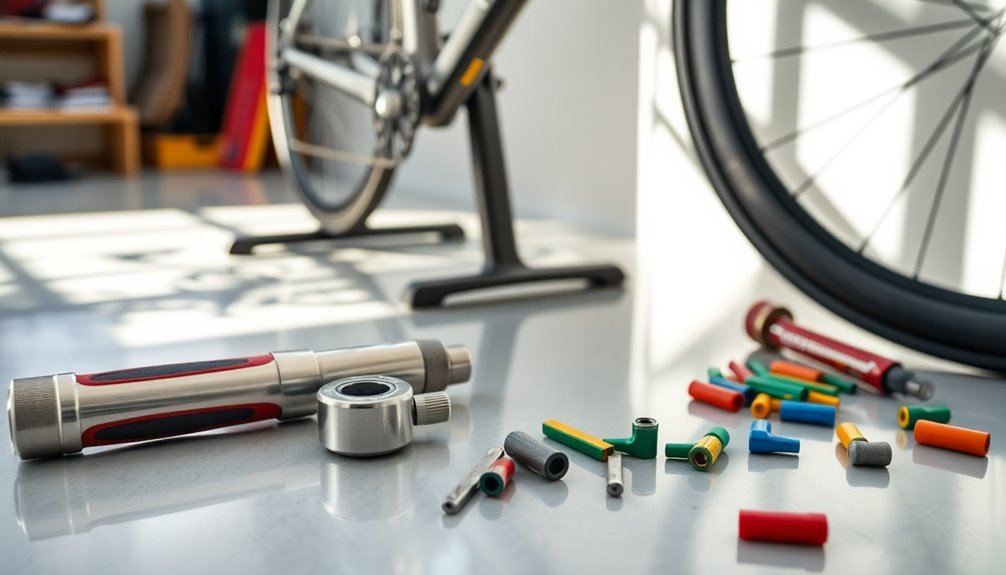
When it comes to bike maintenance, having the right tools on hand can make all the difference.
You'll want to invest in essentials like a quality bike repair stand and a thorough Allen wrench set to tackle most repairs.
Additionally, routine maintenance tools, such as chain lube and tire levers, are key to keeping your ride smooth and reliable.
Must-Have Tool Essentials
To keep your bike in top shape, you'll need a solid set of tools that makes maintenance easy and effective. Start with a thorough tool kit that includes a high-quality Allen wrench set (2-12mm) for adjusting and assembling components.
A sturdy bike repair stand elevates your ride, allowing for precision during maintenance tasks. Tire levers are vital for quick flat repairs, enabling you to remove tires effortlessly without damage.
Don't forget a reliable chain tool for replacing damaged links, ensuring smooth shifting and ideal drivetrain efficiency. Finally, invest in a floor pump with a pressure gauge to maintain proper tire pressure, enhancing performance and reducing flats.
With these essentials, you'll be well-equipped for DIY bike maintenance!
Routine Maintenance Tools
Routine maintenance tools are essential for keeping your bike running smoothly and guaranteeing a safe ride. Here's a quick overview of must-have tools for basic bike repair:
| Tool | Purpose | Importance |
|---|---|---|
| Allen Wrench Set (2-12mm) | Adjusts most bolts without stripping | Versatility |
| Tire Levers | Removes/install tires without damage | Flat repairs |
| Floor Pump with Gauge | Maintains ideal tire pressure | Performance & safety |
| Torque Wrench | Assures bolts are tightened properly | Prevents damage |
With these routine maintenance tools, you'll easily keep your bike in top shape. Don't forget to regularly check tire pressure and lubricate your chain for a smooth ride!
Routine Maintenance for Drivetrain Components

To keep your bike's drivetrain in top shape, you should focus on chain cleaning techniques and gear alignment checks.
Regularly cleaning your chain with the right products helps prevent wear and guarantees smooth shifts.
Plus, checking the alignment of your gears can make a big difference in your overall riding experience.
Chain Cleaning Techniques
While keeping your bike chain clean might seem like a small task, it plays an essential role in maintaining the overall health of your drivetrain components.
Start by using effective chain cleaning techniques, like a dedicated chain brush and a bike degreaser. Isopropyl alcohol works great for removing grime, but specialized bike degreasers are even better.
After you clean a bike, rinse thoroughly and dry the chain. Don't forget to apply high-quality chain lube afterward to keep it running smoothly and prevent rust.
Incorporating these steps into your routine maintenance will enhance performance and extend the lifespan of your drivetrain components.
Also, consider using a chain gauge annually to check for wear; catching issues early can save you from costly repairs in your DIY bike repair efforts.
Gear Alignment Checks
After verifying your bike chain is clean and well-lubricated, it's time to focus on gear alignment checks. Regularly check your gears to confirm they shift smoothly; misalignment can hinder performance. Inspect derailleur hangers for bending, as even a slight misalignment can impact shifting.
Use the barrel adjuster on your shifter to fine-tune cable tension—turning it anti-clockwise increases tension and can enhance shifting precision. Check your inner cable and chain for wear, essential drivetrain components that may need replacing.
| Check | Action |
|---|---|
| Derailleur Alignment | Inspect for bending |
| Cable Tension | Adjust with barrel adjuster |
| Drivetrain Inspection | Look for frayed cables or wear |
Gear Shifting and Inspection Techniques
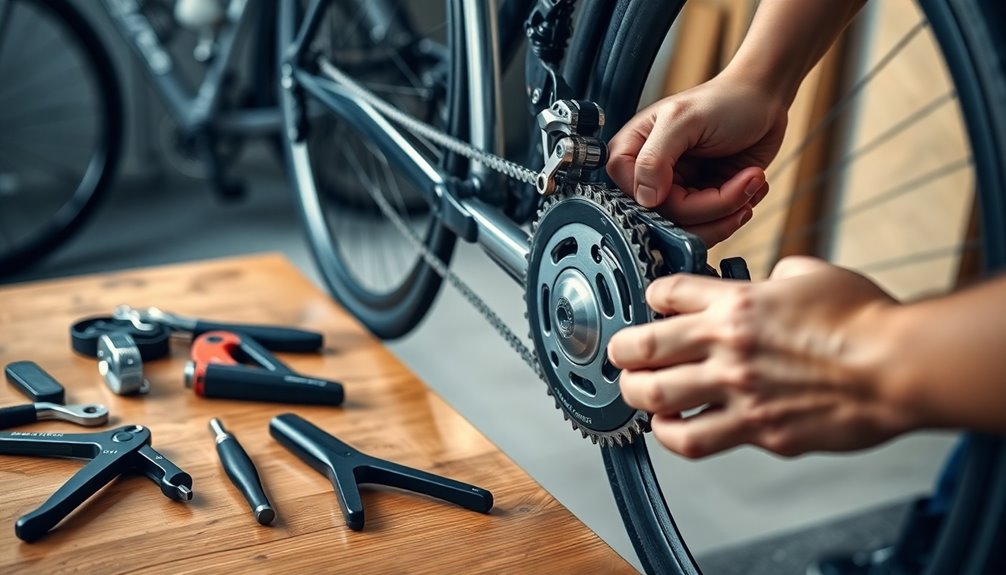
Guaranteeing your bike's gears shift smoothly is essential for a seamless riding experience, as misalignment can lead to frustrating performance issues.
To keep your gear shifting on point, follow these inspection techniques:
- Check derailleur cables: Inspect for fraying or damage, which can affect shifting accuracy.
- Inspect the derailleur hanger: A bent hanger often causes poor shifting, so verify alignment between the cassette and derailleur.
- Adjust cable tension: Use the barrel adjuster on your shifter. Turn it anti-clockwise to increase tension for smoother shifts.
- Examine drivetrain components: Regularly check the inner cable and chain for wear; timely replacements guarantee peak performance.
Tire Maintenance and Repair

Proper tire maintenance is essential for a safe and enjoyable ride. Start by checking your tire pressure before each ride; keeping it within the recommended 25-35 PSI improves grip and comfort while reducing flat risks.
Use tools like tire levers to safely remove tires and replace tubes when necessary. Always carry a spare tube for quick repairs, and make sure you install it without twists for peak inflation.
For tubeless tires, Slug Plugs work well for small punctures, while larger tears might need a tube.
Regularly inspect your tires for wear, looking for reduced tread depth or cracks. A tire gauge helps assess tread wear, making certain you replace tires promptly to maintain safety and traction on your rides.
Brake System Maintenance
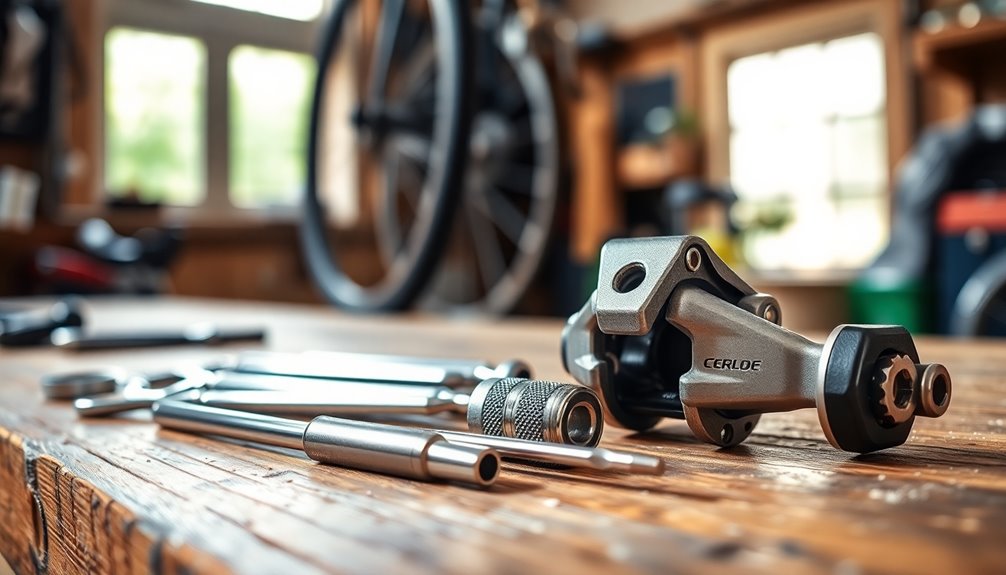
Your bike's brake system is essential for safety, so regular maintenance is a must. Here are some key steps to keep your brakes in top shape:
- Inspect Brake Pads: Regularly check for wear. Replace your chain if it's worn, as this can affect your braking performance.
- Check Caliper Alignment: Misaligned calipers lead to uneven pad wear and reduced efficiency.
- Bleed Hydraulic Brakes: Periodically remove air bubbles to maintain proper function; follow the manufacturer's guidelines.
- Use a Torque Wrench: Tighten brake components to the specified torque settings to prevent damage and guarantee consistent performance.
Don't forget to clean your brake rotors with isopropyl alcohol to keep them free from contaminants. Additionally, regular inspections can help identify potential problems before they escalate into costly repairs.
Happy riding!
Advanced Bike Repair Tools
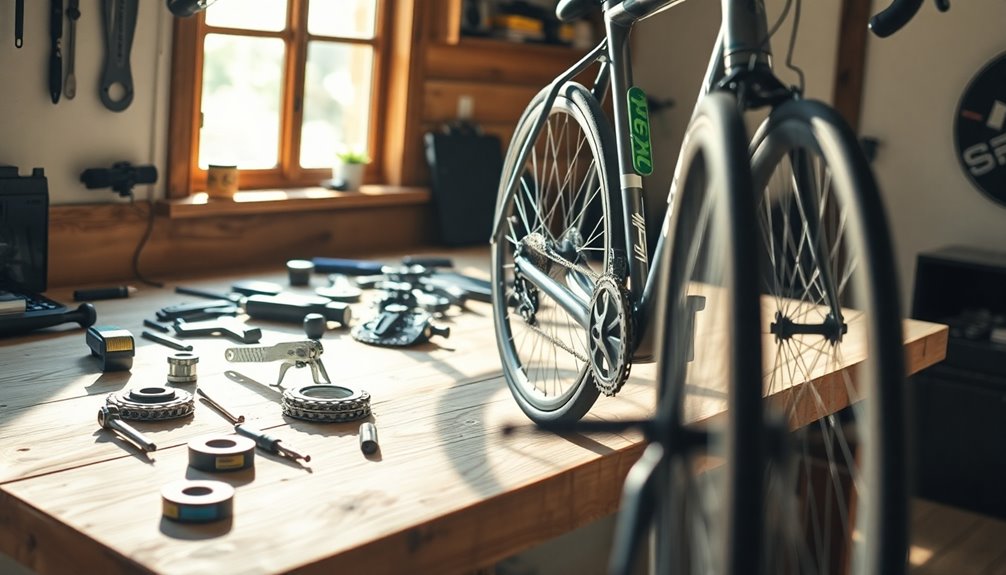
After taking care of your bike's brake system, it's time to equip yourself with the right tools for advanced repairs.
A torque wrench is essential for ensuring bolts are tightened to the manufacturer's specifications, preventing damage during assembly.
You'll also need a chain breaker to adjust chain length or replace worn chains, which helps maintain smooth gear shifting.
For braking performance, a rotor truing tool allows you to make precise adjustments to warped disc rotors, eliminating rotor rub.
Don't forget a derailleur alignment gauge; it helps straighten derailleur hangers for peak shifting performance.
With these advanced tools, you'll tackle repairs like a pro, keeping your bike in top shape for all your rides.
Tips for Effective Cleaning and Lubrication

When it comes to keeping your bike in top shape, choosing the right cleaning tools is essential.
You'll want to use a dedicated chain brush and degreaser for effective cleaning, followed by proper lubrication techniques to guarantee smooth performance.
Let's explore how to clean and lubricate your bike like a pro.
Cleaning Tools Selection
Selecting the right cleaning tools is essential for maintaining your bike's performance and longevity.
Here's a quick list of must-have cleaning tools:
- Chain Brush: Use this with a degreaser to keep your chain clean, ensuring smooth shifting and preventing wear.
- Microfiber Cloths: These are perfect for wiping down surfaces without scratching.
- Spray Bottle: Ideal for applying bike wash to the frame, helping to remove dirt without risking damage to sensitive components.
- Avoid High-Pressure Washers: They can force water into bearings, leading to potential damage.
Having these cleaning tools organized and accessible will streamline your maintenance routine.
Proper Lubrication Techniques
Cleaning your bike regularly sets the stage for effective lubrication, which is essential for maintaining its performance. Use a chain cleaning tool with a degreaser to remove dirt and grime. Once the chain is clean and dry, apply a high-quality bike-specific chain lube. Pedal backward while applying, ensuring even coverage without oversaturating. Wipe off excess lube to prevent dirt buildup.
| Step | Action | Frequency |
|---|---|---|
| 1. Clean | Use degreaser and chain cleaning tool | Every few rides |
| 2. Lubricate | Apply bike-specific chain lube | After cleaning |
| 3. Inspect | Regularly inspect for dryness or noise | Every ride |
| 4. Wipe excess | Remove leftover lube | After lubrication |
| 5. Repeat | Maintain consistent maintenance | As needed |
The Benefits of a Bike Repair Stand

A bike repair stand is an invaluable tool for any cyclist, offering numerous benefits that enhance your maintenance experience. Here are some key advantages:
- Improved Access: Elevates your bike, giving you better access to components without flipping it upside down.
- Better Ergonomics: Reduces the need to bend over, promoting comfort during bike maintenance tasks.
- Versatile Repairs: Supports a wide range of repairs, from simple tune-ups to complex adjustments, making it an essential tool in your toolkit.
- Easy Storage: Many stands feature lightweight designs and quick clamping systems, perfect for those with limited garage space.
Investing in a quality bike repair stand, even at entry-level prices under $200, is a smart choice for any cyclist serious about bike maintenance.
Learning Resources for DIY Bike Maintenance
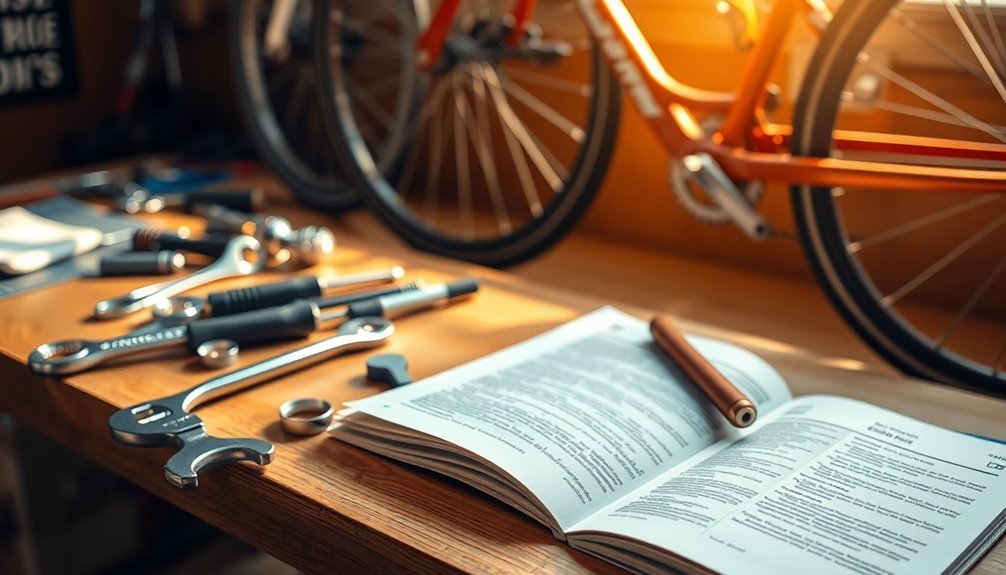
When you're enthusiastic to tackle DIY bike maintenance, having the right learning resources at your fingertips can make all the difference.
Start by investing in a thorough bike repair manual; it offers step-by-step instructions and diagrams for common tasks.
Explore online tutorials and videos from reputable cycling websites to visually grasp techniques at your own pace.
Joining local cycling clubs or community workshops is also beneficial, as they often provide hands-on classes led by experienced mechanics.
Don't forget to utilize mobile apps designed for bike maintenance, which can remind you of scheduled tasks and offer tailored tips.
Engage with cycling forums and social media groups to ask questions and share experiences with fellow DIY enthusiasts.
Frequently Asked Questions
What Tools Do I Need for Basic Bike Maintenance?
For basic bike maintenance, you'll need a few essential tools.
Start with a thorough Allen wrench set to adjust components easily. A T25 Torx wrench is handy for emergencies.
Don't forget a quality floor pump with a pressure gauge to keep your tires inflated. Tire levers are vital for changing flats, and a chain tool is necessary for fixing or replacing chains.
Finally, a bike repair stand makes maintenance tasks much simpler.
What to Buy for Bike Maintenance?
When you're looking to buy tools for bike maintenance, focus on essentials like a high-quality Allen wrench set, which fits most hex bolts, and a reliable floor pump with a pressure gauge for ideal tire pressure.
Don't forget tire levers for easy tire removal and a chain tool to fix any link issues.
Investing in a bike repair stand will elevate your bike, making maintenance tasks more efficient and accessible.
What Regular Maintenance Should Be Done on a Bike?
To keep your bike in top shape, regularly inspect and clean the drivetrain, especially the chain, and replace it if it shows signs of wear.
Check your tire pressure weekly and inflate them to the recommended level for better grip.
Don't forget to examine brake pads for wear and replace them as needed.
Monthly, inspect cables for damage, and clean and lubricate your chain every 100-200 miles to guarantee a smooth ride.
What Should Be in a Bike Tool Kit?
When you're putting together a bike tool kit, make sure you include a hex wrench set (2-12mm) and a T25 Torx wrench for handling most bolts.
Don't forget tire levers, a floor pump with a pressure gauge, and a chain whip for tire maintenance.
For drivetrain care, pack a chain breaker tool and screwdrivers.
Finally, invest in a good repair stand; it'll elevate your bike and make maintenance much easier for you.
Conclusion
In the end, you might think all this bike maintenance is a hassle, but isn't it ironic how a little effort can save you from a costly trip to the shop? By investing time in these essential tools and techniques, you're not just keeping your bike in shape—you're also becoming your own mechanic. So, next time you're tempted to overlook that squeaky chain or worn tire, remember: a little DIY can go a long way in keeping your ride smooth.









